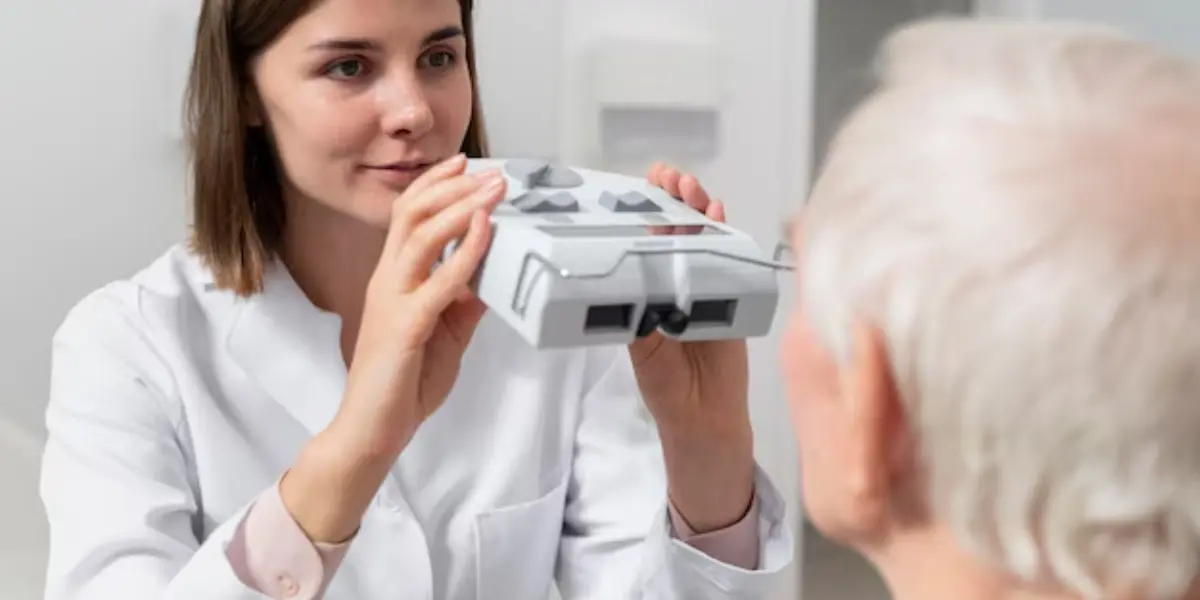Are you finding it increasingly difficult to decipher characters that are close to your eyes? If reading without glasses becomes complicated, you could well be suffering from presbyopia! Rest assured, this is not inevitable. Presbyopia is an age-related vision defect.
What Is Presbyopia And How It Is Corrected? Presbyopia Prevention Tips
It is characterized by difficulty focusing objects and characters up close, such as texts. Presbyopia is due to a reduction in the elasticity of the lens, the eye no longer being able to focus on nearby objects.
Presbyopia is a natural and inevitable phenomenon. It generally appears after the age of 45. Here’s everything you need to know about presbyopia from diagnosis to treatment.

Presbyopia: explanations, symptoms, and prevention. from the age of forty, few individuals can escape presbyopia, an eye disorder linked to aging.
What Is Presbyopia?
Presbyopia is one of the most common eyes. the natural aging of the organ of vision affects certain functions such as focus, also called focusing. This phenomenon appears when the eyes tire and are no longer able to adjust correctly to see the elements located near them, whether they are objects or letters.
The lens is the main culprit of this unpleasant pathology. This membrane becomes less elastic over time and its accommodation capacity decreases, which affects near vision.
What Are The Symptoms Of Presbyopia?
The appearance of increasing discomfort during reading and observing close objects, while distance vision remains unchanged, is the most suggestive symptom of presbyopia. People affected by this optical defect tend to hold their books at arm’s length and move away from their computer screen to see them properly.
They often find themselves squinting to read and have difficulty identifying small print, especially in dim lighting conditions. Excessive blinking and signs of visual fatigue such as blurred vision and headaches after trying to concentrate, are other symptoms of presbyopia.
What Causes Presbyopia?
Presbyopia is linked to the natural aging of the crystalline lens, the lens of the eye located behind the iris. With age, the lens loses its elasticity through thickening and accumulation of cells. Accommodation, that is to say, the change in the curvature of the lens which allows the transition from distance vision to near vision, then becomes less effective.
The ciliary muscle makes it more difficult to modify the shape of the lens, which becomes rigid. As the lens is insufficiently convex, the focusing of light rays in the eyeball occurs outside the plane of the retina ( the rays converge behind the retina). The presbyopia eye can no longer focus on close objects, which becomes blurry
How Is Presbyopia Diagnosed?
To carry out the tests necessary to diagnose presbyopia, you must consult an ophthalmologist. If presbyopia is suspected, the patient will be given a reading test by placing a book approximately 35 cm from the patient’s eyes.
The patient’s left eye and then the right eye will be masked alternately for better analysis of the situation. The results of this test allow the ophthalmologist to know the extent of presbyopia in each eye and to determine the most suitable treatment.
Management Of Presbyopia
Vision loss related to presbyopia can be corrected in several ways. After carrying out a visual assessment, including an eye examination and a visual acuity test, your ophthalmologist will determine the best solution with you.

✨ Adapt Your Daily Habits
When presbyopia is beginning, keeping reading materials away and increasing ambient light may be enough to regain good visual comfort. Myopes will be able to benefit from a clearer near view to read or work on a screen by simply removing their distance correction.
✨ Wear Glasses Or Contact Lenses
When the visual defect causes too much discomfort, wearing prescription glasses is indicated. You will be prescribed a frame equipped with convex lenses to correct your near vision when practicing activities such as reading. DIY or sewing.
It will need to be removed to see from afar. If you already have an optical correction, for example for myopia or astigmatism, the correction of presbyopia will be added to it.
There are also contact lenses that correct blurred vision caused by presbyopia. However, they are not suitable for all eyes and all patients. Even when using contact lenses for presbyopia, it is recommended that you have a pair of glasses to wear when the lenses are removed.
What’s The Treatment For Presbyopia?
Glasses, lenses, laser surgery? In the majority of cases, it is recommended to correct presbyopia for greater daily comfort. For this, the ophthalmologist can prescribe several solutions, such as:

- Wearing corrective glasses adapted to presbyopia.
- Wearing contact lenses adapted to presbyopia.
- Progressive lenses may be recommended by the specialist doctor. Furthermore, it is possible to benefit from glasses or contact lenses made to correct several vision disorders, such as myopia and presbyopia for example. As the level of presbyopia changes over time, it is necessary to consult your ophthalmologist every 1 to 2 years to reassess the situation and be sure to benefit from the best possible correction when you are presbyopic.
- It is also possible to benefit from surgical intervention to correct presbyopia. The most common procedure is refractive surgery, which is performed with a laser. In summary, the ophthalmic surgeon cuts a strip in the cornea and then reshapes it. Another technique can also be practiced to treat presbyopia. This involves replacing the lens, whose aging is the cause of the problem, with a multifocal implant which will correct vision.
Also Read:- Vision Improvement Techniques: A Complete Guide
Final Thoughts
Nothing can prevent presbyopia from developing. To avoid the inconvenience linked to this vision problem, it is better to prepare for it and plan regular visits to the ophthalmologist. At the first signs of presbyopia, the latter can prescribe suitable glasses, even if your problem is slight.
In this way, the disorder goes almost unnoticed and it is easier to accept it. As this pathology progresses, your lenses will need to evolve to be able to compensate for your visual defect. At the same time, take care of your eyes throughout your life.
References:
- Al-Khersan H, Flynn HW Jr, Townsend JH. Retinal Detachments Associated With Topical Pilocarpine Use for Presbyopia (https://pubmed.ncbi.nlm.nih.gov/35609677/). Am J Ophthalmol. 2022;242:52-55. Accessed 7/6/2023.
- Fricke TR, Tahhan N, Resnikoff S, et al. Global Prevalence of Presbyopia and Vision Impairment from Uncorrected Presbyopia: Systematic Review, Meta-analysis, and Modelling (https://pubmed.ncbi.nlm.nih.gov/29753495/). Ophthalmology. 2018;125(10):1492-1499. Accessed 7/6/2023.
- National Eye Institute (U.S.). Presbyopia (https://www.nei.nih.gov/learn-about-eye-health/eye-conditions-and-diseases/presbyopia). Accessed 7/6/2023.